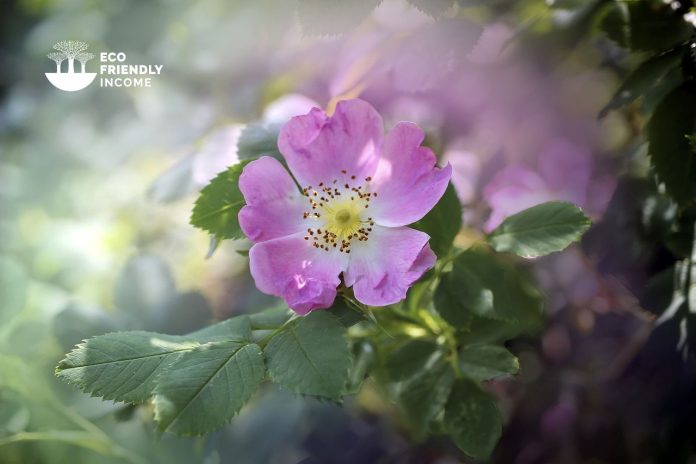A field guide on how to identify and propagate Wild Rose (Rosa acicularis), a hardy zone 2 perennial shrub that is native to North America.
Wild roses, unlike the modern cross-bred species, are always pink! They’re among the most beautiful native flowers in North America, and produce a pleasant fragrance when blooming.
The stems are prickly, which can be a good thing if you’re using them as a hedge. The showy flowers also attract all sorts of beneficial birds and insects.
Note: Did you know you can use wild rose hips as natural medicine? The carotenes found inside the hips have been linked to cancer prevention.
All in all, wild roses make great garden plants with multiple uses. They’re a great forest crop, and since they’re a native species, you’ll only be helping your local environment by planting them at home!
In this guide, we’ll look at how to identify wild rose and how to propagate it.
Let’s get right to it!
Table of Content
How to Identify Wild Rose (Rosa acicularis)
Leaves
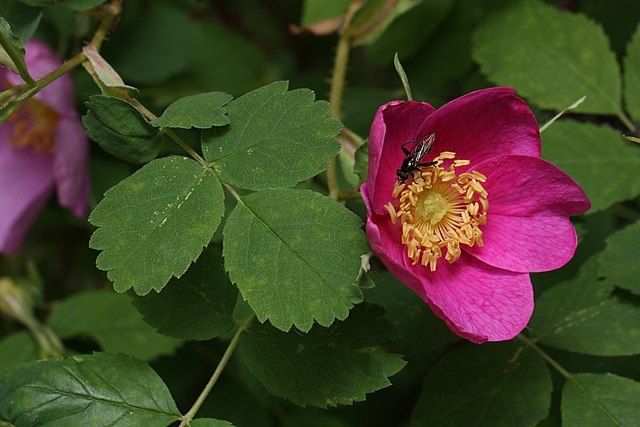
Wild rose (Rosa articularis) leaves are opposed and pinnately compound with 3-7 leaflets. The leaflets are obovate to elliptical in shape with serrated margins.
Wild rose stems are covered in thin but numerous prickles.
Flowers
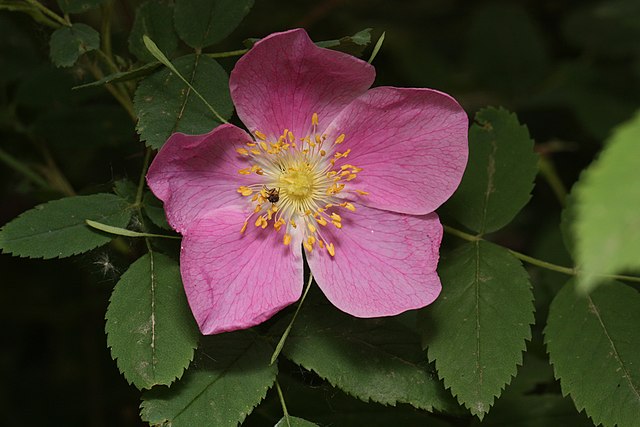
The flowers of the wild rose (Rosa articularis) are delicate, with five petals each. They range in color from deep to light pink, and have a characteristic sweet fragrance. The center of the singular flowers is yellow and filled with nectar.
Fruit
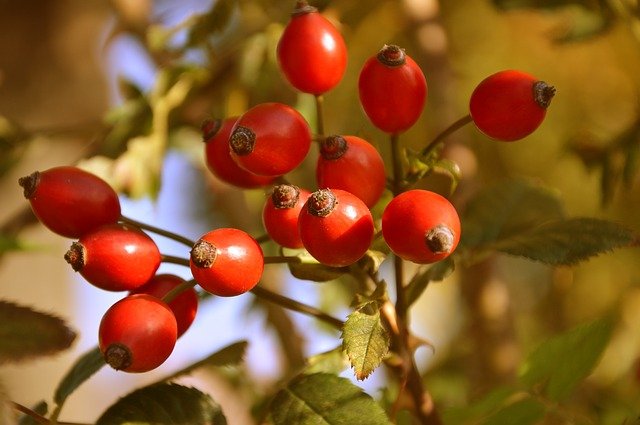
Wild rose hips are the fruit of the wild rose plant and are typically red or orange in color.
Within each hip ranges from 1-22 seeds, with around 7 on average.
Medicinal use: The flesh of rose hip is edible, they are rich in Vitamin C and other nutrients, and have been used for centuries as a natural remedy for a variety of ailments. Rose hips can be eaten raw, cooked, or made into a tea, and are often used in jams, jellies, and other preserves.
Flowering Season
You can enjoy wild rose blooms typically from late spring to early summer.
Habitat
Wild roses are often found in woodlands, along roadsides, and in other disturbed areas. Creeksides such as culverts are often great spots to look for wild roses.
Personally, I’ve often seen wild roses grow naturally where the soil is sandy. Look for them in sandy lakesides or sandy pine forests.
Wild Rose grows naturally from the boreal forests of Canada down to Northern USA.
Wildlife Value
Wild rose provides food and shelter for a variety of animals. Rose hips are a source of food for many birds and small mammals, while the thorns provide protection from predators.
The flowers are also a source of nectar for bees and other pollinators.
Attracts:
- Hummingbirds
- Songbirds
- Grouse
Some boreal forest mammals such as bears, beavers, and rabbits may also browse the plant.
How to Propagate Wild Rose (Rosa acicularis)

Hardiness Zone: 2-6

Soil Type: Well-drained clay, loam, sand.

Water: Normal.

Exposure: Full Sun to Partial Shade.
There are a couple of effective ways to propagate wild rose. You can take semi-hardwood cuttings, or you can grow them straight from the seed.
We’ll take a look at both:
How to Propagate Wild Rose (Rosa acicularis) with Cuttings
It’s possible to propagate wild rose by taking semi-hardwood cuttings.
The best time to do this is after the roses have bloomed. Give or take, it’s usually 6 weeks after the first leaves have emerged.
Wild rose semi-hardwood cutting season is from mid-June to late August. At that time, the year’s growth had enough time to partially harden.

Here’s how to do it:
Note: Wear a pair of gloves because wild roses are prickly!
- First, identify this year’s new growth.
- Next, take cuttings just below where the stem turns from green to brown.
- In general, a good length for cuttings is 6-8 inches, but more importantly, make sure the width is thick enough, 1/8-1/4 inch each is good.
- When you cut, you want to do it at an angle and below a node, then scuff up the bottom inch of your cuttings.
- Remove all of the leaves from the cutting except for 2-3 at the top.
- Moisten your cuttings, then dip in rooting hormone.
- Prepare your rooting medium by poking holes through it, then insert your cuttings, and tamp the soil.
- Keep watering the cuttings to maintain humidity, and cover them with plastic if the humidity is too low.
- Roots will form within 3-4 weeks, from there you can uncover and let them grow more foliage before transplanting.
Recommended Rooting Medium: Pure peat or sand/perlite/peat mix.
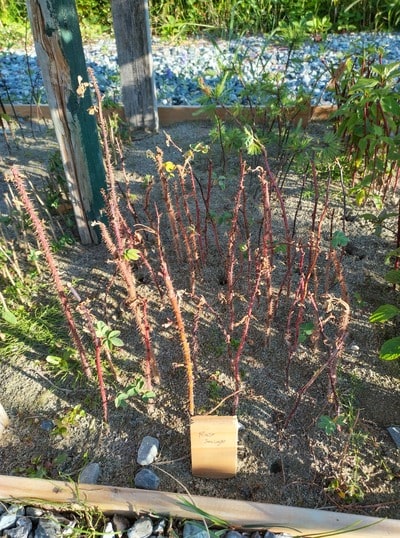
How to Propagate Wild Rose (Rosa acicularis) by Seed
Of course, you can also propagate wild roses by planting their seeds. You can get wild rose seeds from the rose hips that appear later in the season.
Each rose hip has around 5-7 seeds. You can harvest them by letting the hips dry first, then taking the seeds out by hand.
Alternatively, you can use a pestle and mortar lightly to separate the pulp from the seed, then rinse it through a screen to gather the seeds.
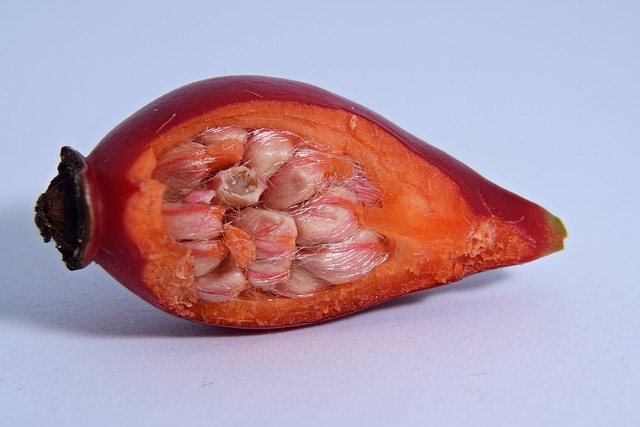
New Option: Buy directly from us!
If you don’t have access to wild rose plants, we do have some wild rose seeds on hand for sale below (collected on September 22, 2023).
We offer free lettermail shipping everywhere in Canada for orders over $20.
Email us at [email protected] for details.
Wild rose seeds come from fruits and need to go through warm-cold stratification to germinate.
You can plant them outside as soon as possible (mid to late summer) and let nature do the work, or you can do it yourself indoors.
How to cold stratify at home:
- Place the seeds in a ziplock back with a little bit of moist sand or vermiculite (must be sterile), and tag them with name and date.
- Warm stratify them at room temperature for 90 days. At the 3-month mark, you can take them out and place them in room-temperature water for 12 hours (scarification to soften the seed shell).
- Finally put them back in the ziplock and this time place them in the refrigerator for another 90 days.
It’s a long process, but gardening is a skill of patience, isn’t it?
After this, your seeds have been stratified, you can safely plant them in soil, moisten and cover them with a light layer of soil.
Seeds should germinate within 1-2 weeks.
FAQ
Q: Can you plant wild rose cuttings straight into the ground?
A: Yes, when the cutting has a nice bundle of roots, you can safely transplant it into the ground in fresh soil.
Q: How do you root wild rose?
A: Simply said, how you root wild rose is all about if you take the cutting at the right time, and if you cut it at the right thickness and length. Afterward, put it into a 50/50 sand/peat mix, give it enough moisture, protect it from the sun, and your cutting should root.
Q: Is it better to root wild rose in soil or water?
A: It’s better if you root them in soil, the success rate to root wild rose is much higher in soil than in water.
Q: What time of the year is it best to take wild rose cuttings?
A: The best time to take cuttings from wild rose is at least 6 weeks after the first leaves have emerged, and after the flowers bloomed.
Q: What is the fastest way to root rose cuttings?
A: The fastest way to root rose cuttings is to place them in sand, with rooting hormone, inside a small greenhouse.
Q: How long does it take for rose cuttings to root?
A: Wild rose cuttings can start making roots within 2 weeks, but isn’t ready to transplant until 6 weeks.

